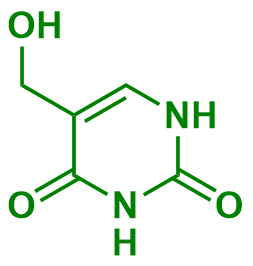5-Hydroxymethyluracil Analysis Service
- Identification of novel disease biomarkers
- Improvement in disease diagnosis
- Acceleration in the discovery of innovative therapeutics
- Unraveling new insights into disease mechanisms
- Animal tissue ≥ 100 mg
- Plant tissue ≥ 200 mg
- Serum/ Plasma ≥ 200 μL
- Urine ≥ 2 mL
5-Hydroxymethyluracil (5-hydroxymethyl-2,4(1H,3H)-pyrimidinedione) is a nitrogen-containing organic compound that belongs to the class of pyrimidine derivatives, with the chemical formula C₅H₆N₂O₃. It is an analogue of uracil, featuring a hydroxymethyl group at the 5-position. 5-Hydroxymethyluracil is synthesized in living organisms through metabolic pathways involving uracil and related compounds. It is found in various biological systems, including bacteria and plants, where it may play roles in nucleic acid metabolism. As a nucleobase, it can participate in the formation of RNA, where it pairs with adenine (A) during transcription processes. The metabolism of 5-hydroxymethyluracil involves enzymatic modifications, allowing it to be interconverted with other nucleobases and nucleotides. This compound is significant in the context of RNA stability and function, as well as in the regulation of gene expression and cellular processes. Additionally, 5-hydroxymethyluracil may have implications in plant growth and development. Its levels can serve as indicators of physiological responses in plants under various stress conditions, such as nutrient deficiency, salinity, and disease. By studying 5-hydroxymethyluracil and its derivatives, researchers can gain insights into nucleotide metabolism, RNA dynamics, and the molecular mechanisms underlying cellular functions and stress responses in plants.

Figure 1. The Structure of 5-Hydroxymethyluracil
Mass spectrometry-based metabolomics methods can simultaneously detect and quantify thousands of metabolic features and are widely used for the metabolic analysis of various compounds. MtoZ Biolabs utilizes an LC-MS-based metabolomics research platform for the analysis of 5-hydroxymethyluracil. We ensure the accuracy of the quantification of 5-hydroxymethyluracil and its metabolites, as well as the comprehensiveness and precision of metabolite identification. If you would like to learn more about our 5-hydroxymethyluracil analysis services, please feel free to contact us, and we will be more than happy to assist you.
Analysis Workflow
Service Advantages
1. Experienced: MtoZ Biolabs has a professional research team and advanced technical equipment, capable of providing high-quality services and support to meet the specific needs of clients.
2. Wide Applicability: It is suitable for various types of samples, including plants, animals, and biological fluids, making it applicable across a broad range of fields.
3. High Throughput: Mass spectrometry technology can analyze multiple metabolites simultaneously in a short time, making it suitable for high-throughput analysis of large-scale samples.
4. Targeted Compounds: Targeted metabolomics focuses on specific metabolites, effectively eliminating interference signals and enhancing the reliability of the data.
5. Strong Detection Capability: Mass spectrometry technology can detect low concentrations of metabolites, making it suitable for analyzing rare or complex components in biological samples.
Applications
Sample Submission Requirements
1. Sample Types
Serum, plasma, urine, tissues, and other biological samples. A minimum of three replicates per condition is required for each sample.
2. Sample Volume
3. Sample Preservation
Store at -80°C to ensure stability.
Note: Please provide details on sample collection and handling.
Deliverables
1. Experimental Procedures
2. Relevant Liquid Chromatography and Mass Spectrometry Parameters
3. Detailed Information on 5-Hydroxymethyluracil
4. Raw Data
5. Custom Analysis Report
Through our 5-hydroxymethyluracil analysis service, we strive to support your research and product development efforts by providing accurate and reliable results. Trust MtoZ Biolabs for your 5-hydroxymethyluracil analysis needs.
How to order?







